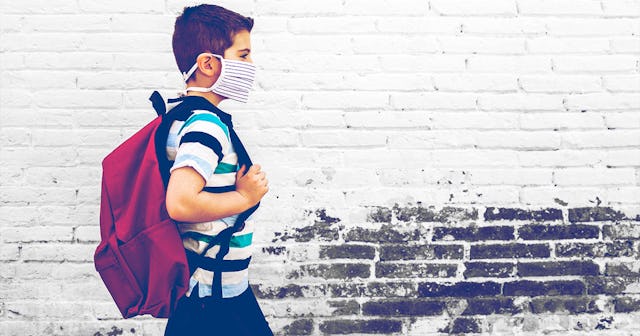We Are Overlooking A Critical Piece Of The 'Reopen Schools' Puzzle

Before we start arguing one more time about opening schools and how much children need socialization, check your privilege. Who’s most likely to be affected by COVID-19?
As the CDC says, “systemic health and social inequalities” have put people of color “at a far more disproportionate risk” of getting sick and dying from COVID-19. They are more likely to be uninsured, and their healthcare access can be limited. They’re also more likely to be essential workers, to make less money, and “live in crowded conditions that make it more challenging to follow prevention strategies.” While not all people of color are low income, they are, as the CDC says, “at a far more disproportionate risk” of it. Opening schools, then, creates a much higher risk for low-income families and people of color, who are already at a higher risk of contracting COVID-19.
Yes, Kids Get COVID… And They Can Transmit It
When we talk about opening schools, we have to say this again: yes, children contract COVID-19. A new study in the Journal of Pediatrics examined 192 children: 49 diagnosed with acute COVID-19; 18 with the dangerous COVID-19 complication of MIS-C. Only half the kids with COVID had a fever. However, all the kids were “a potential source of contagion… in spite of milder disease or lack of symptoms.”
As the study researchers conclude: “[C]hildren may be a potential source of contagion in the SARS-CoV-2 pandemic in spite of milder disease or lack of symptoms, and immune dysregulation is implicated in severe post-infectious MIS-C.”
Basically: the temp checks at the schoolhouse door won’t help, because many kids don’t get fevers, or have asymptomatic infections. Also? Despite the fact that their infections are usually milder, they can pass the virus on to others.
Opening Schools Means Kids Take COVID-19 Home…
Remember how many of those low-income students live in multi-generational households, or in apartments, or in conditions that otherwise make social-distancing measures difficult? In The New York Times, high school senior Isaac Lozano talks about something as simple as visiting the laundromat as a dangerous trip filled with unmasked people. Consider that privileged folks can avoid both the laundromat and the unmasked. He can’t. He risks bringing COVID-19 home.
Now compound that with opening schools.
Many of the people around Lozano live in those multi-generational families… and many of them have members who, because of preexisting conditions, simply cannot contract COVID-19. If they do, barriers to health care— remember those?— can make the consequences dire.
nycshooter/Getty
Isaac lost an uncle to COVID-19; he lost his uncle’s mother to COVID-19. He has friends who also “live in tight quarters” and have had family members contract the virus. Hardly a day goes by when my public school teacher husband doesn’t receive a “bereavement” email notifying him of the death of another student’s close family member. I don’t mean just grandparents and aunts and uncles.
Often, the deceased is a parent.
By opening schools, we throw open the doors of those multi-generational households. With children carrying the viral loads scientists have described in Pediatrics, we’re risking the old, the sick, the most vulnerable low income members of our society by opening schools. We’re risking the ones least able to fight COVID-19.
Opening Schools in Low Income Areas?
Stopping the spread of COVID-19 requires plenty of ventilation. Remember how COVID-19 doesn’t spread well, or at all, outside? Newsflash: many of our schools are falling apart, and they don’t have adequate ventilation, no matter how many fans a teacher runs. According to The Conversation, The U.S. Commission on Civil Rights found that low income students tend to attend “low quality school facilities” that “lack physical maintenance.” They were saying in 2018 that “this could negatively affect a student’s health.”
19% of schools are estimated to have “inadequate ventilation,” and those schools are likely to be the older ones… which are likely to be populated by low income students.
The author of the article, a former superintendent of schools, says that he fears because of building maintenance issues like this. “I fear that the schools and classrooms attended by low-income students of color could become epicenters of a second wave of pandemic,” he commented.
In other words, opening schools in low income areas could send waves of COVID-19 through the surrounding communities.
Virtual Sucks… Opening Schools Is Worse
We’re all worried about kids suffering emotional harm from being away from their peers. We’re all worried about them suffering loss academic ground— especially low income and minority kids, who can ill-afford it. But as Politico says, many of the kids “most disadvantaged by virtual learning” are those same kids we’ve been talking about who are at the greatest risk of bringing COVID-19 home to low-income, multi-generational households “at greatest risk of death and serious illness from coronavirus.” Miami Mayor Francis Suarez says that, ““The No. 1 place where people are reporting being infected is at home,” and he worried, after examining the data, that reopening schools could “create a super-spreader event and a new wave.”
Yes, virtual school is a mess: students aren’t showing up. Districts are losing track of kids, who may not be safe at home; students lack high speed internet and even computers.
But the elderly in their households are still alive. So are the kids themselves: Politico notes that around 500 kids have been hospitalized with COVID-19; Black and Latino kids were hospitalized at a far higher rate. When it comes to contracting MIS-C, a dangerous pediatric inflammatory complication of COVID-19, only 19% of the sufferers were white.
Opening schools simply isn’t a safe option for many students. It certainly shouldn’t be right now, mid-pandemic, for low-income kids who could bring the virus home and infect multi-generational households, putting themselves and others in close quarters at risks. Staying online is far from ideal. But for low income kids, opening schools is worse.